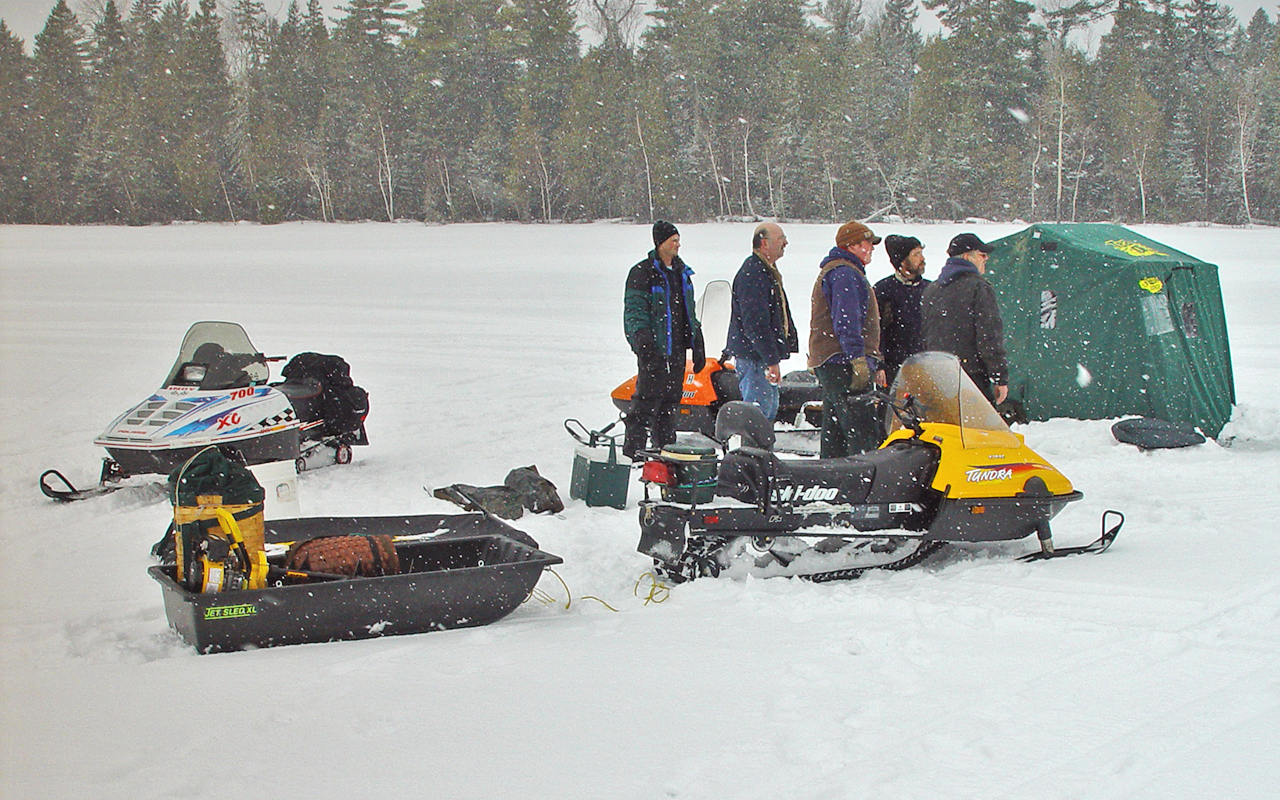
I received a catalog in the mail last week from a world-recognized outdoor equipment supplier. As I paged through it, the technological advancements in fishing and hunting gear made my brain swim.
In particular I compared a recent ice fishing trip to ones I made 60 years ago. There have been multiple new inventions and several dozen improvements and upgrades of already available equipment and materials, but three items stand head and shoulders above all other winter fishing assets that aid hard-water anglers.
First and foremost is the snowmobile. While certainly not invented and manufactured with ice fishing in mind, no other apparatus has expanded the sport more. Before snowmobiles, ice fishermen waded through snow or used snowshoes to access lakes and set out tip-ups. This kept most sportsmen close to plowed, accessible roads. With a snowmobile, even the most distant coves and corners of large lakes can be visited and remote waterways with no plowed roads nearby can still be accessed.
Modern snowmobiles and track-equipped ATVs comfortably carry two fishermen and all the gear, equipment and bait in an attached cargo sled — another wonderful addition to the sport of hard water fishing. Even secondhand snow sleds aren’t inexpensive, but most folks don’t purchase one for the sole purpose of ice fishing transportation. Kept well maintained, these winter wonders operate for decades and most maintain good resale value. But if you still can’t justify the cost, there are two obvious options: join a fishing friend who owns a snowmobile or rent one for a day, weekend, or full week from one of several local shops.

Easy to haul and quick to set up, portable ice fishing huts provide shelter from the wind, a warm interior and light for night fishing outings. (Courtesy of Bill Graves)
The second boon to winter fishermen is the portable ice shanty, offering comfort, convenience and shelter regardless of weather, time of day or lake location. For at least a century, many Maine ice drillers have built their own small huts for winter fishing, utilizing every size, shape and combination of materials. The initial goal was to provide cover and light for smelt fishing at night, which is often a prime time for fast handline action to catch a bucket of these tasty silver slivers. It’s also a convenient time to fish a couple of hours since most people had to work all day.
As years passed, Aroostook anglers realized that they could set out tip-ups and watch from the warm comfort of a heated smelt shanty and even use a jig rod or handline while they waited for a flag. Some of the fishing huts were like a mini house, featuring gas or electric heat, cooking stoves, radio, TV, tables, chairs and even a cot for mid-outing naps. The downside included time and cost of construction, upkeep and the tedious job of transporting and getting the shanty on and off the lake. Owners also had to keep a close watch that the fish hut didn’t freeze in place due to winter rains or sudden ice melts, or sink due to a sudden spring thaw. Also, once you selected a lake and set the shanty in place, that’s where you were for the entire season.
The advent of collapsible, portable fishing huts set on stable, slick moving sleds eliminated most of the drawbacks of the heavy, wooden versions. These easily transportable cabins range in sizes to fit one or up to 10 fishermen, the two- and four-person size being the most popular. With a small propane heater, Coleman lantern and stove, it’s possible to spend hours fishing day or night in comfort at a favorite lake. Then the next weekend you can set up for a day trip on another great waterway; new scenery, different fish, no hassle,- traveling fish huts are a wonderful asset.
The third and newest ice fishing tool has really only caught on the last couple of years. Many fishermen just couldn’t believe a battery-operated ice auger would do the job and stand up to the abuse. With the advanced technology of more powerful and longer-lived battery-operated grass trimmers, power tools, leaf blowers, chain saws and even cars, the ice drill was bound to happen. Oddly, there are a lot of sportsmen who think I’m joking when I first mention this amazing new tool.
New owners and first-time users are even more astonished and impressed with the features and performance. The benefits over a manual auger are obvious, but there are even more over gas- and propane-fueled ice drills. No more small motor problems and tune-ups, no gas to buy, transport and smell up the truck, garage and ice hut. No start cords to pull or recoil systems to repair. No oil to keep track of and no fumes to inhale while drilling.
StrikeMaster, Ion and Jiffy are top ice auger choices, each at least half the weight of a gas model. There’s a choice of 6-, 8- or 10-inch blades and some even come with lights for drilling holes at night. A few models features reverse, and of course there’s no loud annoying motor noise to irritate fish or fishermen. Some augers come with a spare battery and many lithium batteries hold enough power to drill through over 2,000 inches of ice per charge.
Fishing and hunting opportunities are scarce in the winter, especially during Aroostook’s harsh weather. Since outings are supposed to be fun and encourage followup adventures, any device like the three I’ve mentioned is an advantage.
If you can’t rationalize owning all the items, buy one and find an angling friend who has the others. The cost over the next 10 years of fun is reasonable. When it comes to comfort and less work, technology is your friend.







